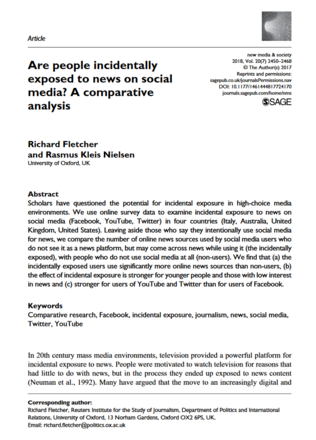
The authors of the article have used online survey data to examine incidental exposure to news on social media (Facebook, YouTube, Twitter) in four countries (Italy, Australia, United Kingdom, United States), comparing the number of online news sources used by unintentional social media users (users who do not see it as a news platform) with people who do not use social media at all. The researchers see only small differences in the effect of incidental exposure to news on social media from country to country. Accordingly they conclude that environments characterised by selective exposure are accompanied by more incidental exposure via social media. They also find that social media use is in fact significantly related to increased news use, even among those who come across news on social media while doing other things.
The article present three main findigs:
- The incidentally exposed users use significantly more online news sources than non-users. Because the average number of news sources used in each country is low, the researchers suggest that any increase in number of sources would necessarily mean an increase in diversity. Providing that the given content is not identical, even adding one more similar source to those consuming news from just one source would constitute an increase in diversity of views. On the other hand, for those who consume news from an above-average number of sources, incidental exposure via social media may indeed result in an echo-chamber effect if all additional sources are highly similar to what is already being used.
- The effect of incidental exposure is stronger for younger people and for those with low interest in news. It follows that incidental exposure to news via social media could potentially reduce knowledge gaps that result from self-selection away from news, especcially in social contexts where information opportunities are scarce. This could also be the case in environments formerly characterised by incidental exposure when media choice was relatively low. The paper suggests that this could lead to outcomes such as civic engagement and political participation.
- The effect of incidental exposure is stronger for users of YouTube and Twitter than for users of Facebook.
Tags: Social media United Kingdom Italy Australia New Zeland Pacific Fake news and disinformationThe content of this article can be used according to the terms of Creative Commons: Attribution-NonCommercial 4.0 International (CC BY-NC 4.0) . To do so use the the wording "this article was originally published on the Resource Centre on Media Freedom in Europe" including a direct active link to the original article page.

